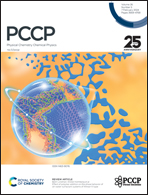Superalkali-alkaline earthide ion pairs of δ+(AM-HMHC)-AM′δ− (AM = Li, Na and K; AM′ = Be, Mg and Ca) possessing large NLO responses and excellent electronic stabilities and alkalide characteristics: a DFT study†
Abstract
To identify superalkali-alkaline earthide ion pairs, it's theoretically shown that, as a novel class of excess electron superalkali compounds, both chair and boat forms of (AM-HMHC)-AM′ (AM = Li, Na, and K; AM′ = Be, Mg, and Ca; HMHC = 1,4,7,10,13,16-hexamethyl-1,4,7,10,13,16-hexaazacyclooctadecane) are good candidates. An attractive superalkali-alkaline earthide ion pair in δ+(AM-HMHC)-AM′δ− is firstly exhibited, which possesses alkaline-earthide characteristics and nonlinear optical response superior to similar M+(calix[4]pyrrole)M′− (M = Li, Na, and K; M′ = Be, Mg, and Ca) with high stability. The electronic and vibrational second order hyperpolarizabilities and the frequency-dependent first hyperpolarizabilities of δ+(AM-HMHC)-AM′δ− are presented. For each pair of (AM-HMHC)-AM′, the boat conformation is preferred to its chair one in the case of Hyper–Rayleigh scattering response (βHRS). These alkaline earthides suggest prominently high βHRS up to 2.59 × 104 a.u. (boat forms of δ+(Na-HMHC)-Caδ−). We expect that this work will inspire the preparation and characterization of these new alkaline earthides as high-performance NLO materials.



 Please wait while we load your content...
Please wait while we load your content...